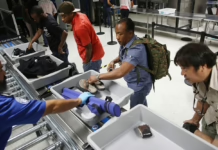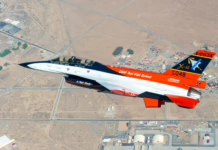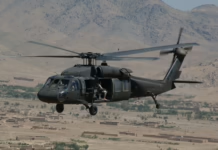Strategic bombers arrive at Spanish base with unprecedented reach across three continents as Pentagon demonstrates resolve from Baltic to Black Sea
The United States Air Force deployed three B-52H Stratofortress strategic bombers to southern Spain on Friday morning, launching the first European bomber task force rotation of 2026 with joint training exercises designed to demonstrate American military reach across Europe’s eastern borders and the Arctic region.
The long-range bombers from the 2nd Bomb Wing at Louisiana’s Barksdale Air Force Base arrived at Morón Air Base near Seville at daybreak Nov. 8, marking the start of multinational combat readiness drills with Finland, Lithuania, Sweden and additional NATO partners. The deployment underscores Washington’s commitment to allied defense as tensions persist along Europe’s eastern frontier.
Flying with call signs CAGER 11 through 13, the massive eight-engine aircraft crossed the Atlantic Ocean with aerial refueling support from KC-46 Pegasus and KC-135 Stratotanker aircraft. Spanish Eurofighter Typhoon fighter jets conducted planned interception exercises with the bombers shortly after their arrival, military officials confirmed.
From their position in southwestern Spain, the strategic bombers can reach targets throughout the Baltic states, Nordic region, Black Sea area and Mediterranean basin without leaving allied airspace. The Air Force indicated crews would also conduct missions extending into Africa and the Middle East during the deployment, which could last from several days to multiple weeks based on operational requirements.
Training scenarios will emphasize operations in contested airspace with sophisticated air defense systems, according to Air Force planning documents. Bomber crews will rehearse the complete targeting cycle — finding, fixing, tracking and engaging objectives — while coordinating with allied fighter aircraft and ground-based air defense networks.
The deployment represents a calibrated display of American strategic capabilities designed to reinforce deterrence through what military planners describe as the three pillars: capability demonstration, alliance credibility and strategic messaging. Unlike permanent basing, these rotational deployments allow the Air Force to project power across multiple theaters while avoiding the diplomatic complications of continuous presence.
The selection of newer NATO members Finland and Sweden for joint training highlights the alliance’s expanding northern focus. Both nations joined the alliance following Russia’s 2022 invasion of Ukraine, transforming the Baltic Sea into what analysts increasingly call a “NATO lake” and extending the alliance’s Arctic presence significantly.
Strategic bombers operating from Morón can patrol critical northern approaches and eastern boundaries while maintaining safe distances from potential threats. This standoff capability allows the B-52s to employ long-range precision weapons without entering heavily defended airspace, a crucial advantage in contemporary strategic planning.
The venerable B-52H platform, originally designed during the height of the Cold War, continues to serve as a cornerstone of American strategic aviation through continuous modernization efforts. Recent upgrade packages have equipped the bombers with advanced electronics, communications systems and weapons integration capabilities that extend their operational relevance well into the 21st century.
Unlike stealth bombers designed to penetrate sophisticated air defenses undetected, the B-52’s value lies in its massive payload capacity, exceptional range and ability to coordinate with allied forces across vast distances. Crews operating the aircraft manage complex navigation, communications and weapons systems while integrating with fighters, tankers and naval vessels in joint operations.
The aircraft’s ability to remain airborne for extended periods without refueling, combined with aerial tanker support, enables continuous presence over areas of interest. This endurance factor proves particularly valuable in demonstrating resolve without escalation, military strategists note.
Recurring bomber task force deployments to Europe validate transatlantic operational procedures, tanker integration protocols and multinational command structures. These missions generate valuable training data while sending clear signals about collective defense readiness without triggering excessive concern among regional actors.
The timing of the deployment coincides with ongoing instability in multiple regions, including continuing tensions in Eastern Europe and active conflicts in the Middle East. Military officials characterize such rotations as routine training evolution rather than responses to specific threats, though the strategic messaging component remains evident.
Command and control procedures tested during these exercises help validate communication channels and targeting protocols across different NATO member forces. The integration of various national air defense systems with American strategic assets requires careful coordination to prevent friendly fire incidents while maintaining operational security.
The bomber task force concept emerged from post-Cold War strategic thinking that emphasized flexible response over permanent forward basing. This approach reduces infrastructure costs while maintaining the ability to project power globally on short notice.

Key Takeaways
- Three B-52H bombers deployed to Spain’s Morón Air Base for first 2026 European rotation, conducting exercises with Finland, Lithuania, Sweden and NATO allies.
- Strategic positioning enables bomber reach across Baltic, Black Sea, Mediterranean, Africa and Middle East without entering hostile airspace.
- Deployment demonstrates NATO deterrence through rotational presence while avoiding permanent basing complications.
- Cold War-era B-52s remain relevant through continuous upgrades, offering massive payload capacity and extended range capabilities.
- Training focuses on complex targeting operations in contested airspace alongside allied fighter and air defense integration.









